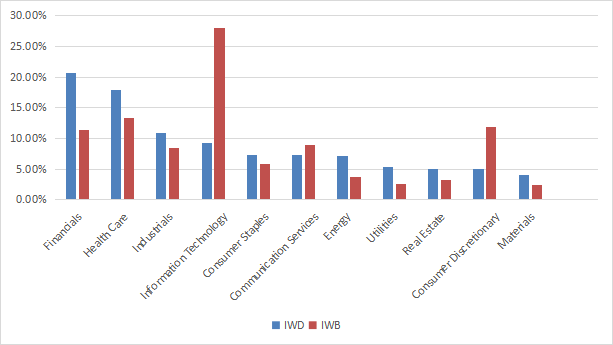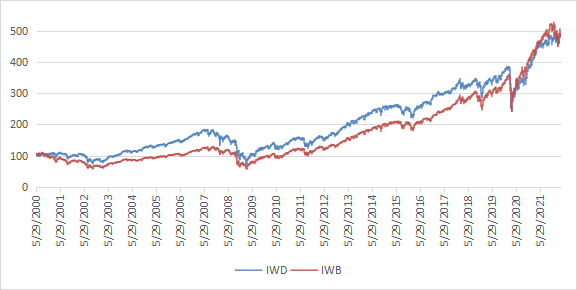takasuu/iStock via Getty Images
IWD strategy and portfolio
The iShares Russell 1000 Value ETF (NYSEARCA:IWD) has been tracking the Russell 1000 Value Index since May 2000. IWD has 849 holdings, a distribution yield of 1.70% and an expense ratio of 0.19%.
As described by FTSE Russell, the underlying index measures the performance of a large cap segment of the US stock market. It includes companies with lower price-to-book ratios and lower expected growth values. The index represents about half of the total market value of the Russell 1000 Index. IWD turnover was 18% of the average value of its portfolio in the last fiscal year.
IWD invests almost exclusively in U.S. companies (98.9% of asset value), mostly in the large cap segment (67.5%). As expected, IWD is cheaper than its parent index Russell 1000 (IWB) regarding the usual valuation ratios reported in the next table.
|
IWD |
IWB |
|
|
Price / Earnings TTM |
16.61 |
21.43 |
|
Price / Book |
2.47 |
4.09 |
|
Price / Sales |
1.97 |
2.84 |
|
Price / Cash Flow |
12.87 |
17.06 |
The top 10 holdings, listed below with valuation ratios, represent 18.3% of asset value. The heaviest position weights about 3%, so risks related to individual stocks are low.
|
Ticker |
Name |
Weight (%) |
P/E TTM |
P/E fwd |
P/Sales TTM |
P/Book |
P/Net Free Cash Flow |
Yield% |
|
Berkshire Hathaway Inc |
3.03 |
8.76 |
27.27 |
2.82 |
1.54 |
29.73 |
0.00 |
|
|
Johnson & Johnson |
2.29 |
24.77 |
17.91 |
5.17 |
N/A |
N/A |
2.46 |
|
|
UnitedHealth Group Inc |
2.26 |
29.88 |
25.18 |
1.75 |
N/A |
37.87 |
1.06 |
|
|
Procter & Gamble Co |
1.86 |
28.92 |
28.00 |
5.31 |
9.51 |
65.84 |
2.23 |
|
|
JPMorgan Chase & Co |
1.83 |
9.76 |
11.89 |
3.15 |
1.55 |
N/A |
3.04 |
|
|
Exxon Mobil Corp |
1.76 |
16.32 |
9.34 |
1.34 |
2.23 |
17.80 |
4.00 |
|
|
Chevron Corp |
1.58 |
21.21 |
11.10 |
2.12 |
2.38 |
29.06 |
3.29 |
|
|
Bank of America Corp |
1.33 |
11.32 |
11.91 |
3.36 |
1.36 |
N/A |
2.12 |
|
|
Pfizer Inc |
1.31 |
12.91 |
6.92 |
3.52 |
3.72 |
13.57 |
3.22 |
|
|
Verizon Communications Inc |
1.08 |
10.23 |
10.00 |
1.70 |
2.77 |
N/A |
4.71 |
The top two sectors are financials (20.7%) and healthcare (17.9%). Compared to the Russell 1000, the fund underweights technology, communication, and consumer discretionary, while overweighting all other sectors.
IWD sectors (chart: author; data: Fidelity)
Since inception in May 2000, IWD annualized returns and risk-adjusted performance (Sharpe ratio) are identical to those of the parent index. The maximum drawdown is a bit deeper.
|
Total Return |
Annual.Return |
Drawdown |
Sharpe ratio |
Volatility |
|
|
IWD |
390.49% |
7.53% |
-60.47% |
0.46 |
15.35% |
|
IWB |
388.29% |
7.51% |
-55.68% |
0.46 |
15.75% |
Data calculated with Portfolio123
The next chart plots the equity values of $100 invested in IWD and IWB since IWD inception. The two funds have alternatively outperformed each other. IWD has been steadily lagging from 2018 to 2021. However, it has outperformed in 2022: IWD is close to flat year-to-date, whereas IWB is down about -7%.
IWD vs. IWB (chart: author; data: portfolio123)
Comparing IWD with my value benchmark
The Dashboard List is a list of 80 stocks in the S&P 1500 index (occasionally less), updated every month based on a simple quantitative methodology. All stocks in the Dashboard List are cheaper than their respective industry median in Price/Earnings, Price/Sales and Price/Free Cash Flow. An exception is Utilities: the Price/Free Cash Flow is not taken into account to avoid some inconsistencies. After this filter, the 10 companies with the highest Return on Equity in every sector are kept in the list. Some sectors are grouped together: Energy with Materials, Telecom with Technology. Real Estate is excluded because these valuation metrics don’t work well in this sector. I have been updating the Dashboard List every month on Seeking Alpha since December 2015, first in free-access articles, then in Quantitative Risk & Value.
The next table compares IWD performance since inception with the Dashboard List model, with a tweak: here the list is reconstituted once a year to make it comparable with a passive index.
|
Total Return |
Annual.Return |
Drawdown |
Sharpe ratio |
Volatility |
|
|
IWD |
390.49% |
7.53% |
-60.47% |
0.46 |
15.35% |
|
Dashboard List (annual) |
1755.02% |
14.27% |
-57.78% |
0.77 |
17.68% |
Past performance is not a guarantee of future returns. Data Source: Portfolio123
The Dashboard List beats IWD by a wide margin in return and Sharpe ratio.
IWD fundamental shortcomings
Why is the difference so large? The underlying index has two shortcomings in my opinion.
The first and largest one is to classify all stocks on the same criteria. It means the valuation ratios are considered comparable across sectors. Obviously they are not: you can read my monthly dashboard here for more details about this topic. A consequence is to privilege sectors where valuation ratios are naturally cheaper, especially financials. Some other sectors are disadvantaged: those with large intangible assets like technology. To make things simple, companies with large intangible assets are those with a business model based on massive R&D, or a strong branding, or large user databases, or operating in a field where competition is limited by an expensive entry ticket. All these elements are not correctly reflected by valuation ratios.
The second flaw is using the price/book ratio (P/B), which first amplifies the intangible asset issue, and second adds some risk in the strategy. Intuitively, we can guess a large group of companies with low P/B contains a higher percentage of value traps than a same-size group with low price/earnings, price/sales, or price/free cash flow. Statistically, such a group will also have higher volatility and deeper drawdowns in price. The next table shows the return and risk metrics of the cheapest quarter of the S&P 500 (i.e., 125 stocks) measured in price/book, price/earnings, price/sales and price/free cash flow. The sets are reconstituted annually between 1/1/1999 and 1/1/2022 with elements in equal weight.
|
Annual.Return |
Drawdown |
Sharpe ratio |
Volatility |
|
|
Cheapest quarter in P/B |
9.95% |
-72.36% |
0.48 |
21.05% |
|
Cheapest quarter in P/E |
11.25% |
-65.09% |
0.57 |
18.91% |
|
Cheapest quarter in P/S |
12.62% |
-65.66% |
0.6 |
20.46% |
|
Cheapest quarter in P/FCF |
12.23% |
-63.55% |
0.61 |
19.05% |
Data calculated with Portfolio123
This explains my choice of using P/FCF and not P/B in the Dashboard List model.
Takeaway
IWD follows a systematic process based on a valuation ratio and various growth metrics to split the Russell 1000 index in Value and Growth subsets, and invests in the value side. It has been unable to outperform its benchmark since inception two decades ago, which is enough time to assess the efficiency of a strategy. It may be part of a tactical allocation strategy, switching between value and growth depending on market conditions.
However, as a buy-and-hold investment, it doesn’t meet expectations of bringing added value to its parent index. It is not worse, either, which is why I give it a “hold” rating. Its Morningstar rating is 3 stars, one star below IWB.
I think there are two flaws in its strategy: it ranks stocks regardless of their sectors, and one of its metrics is the worst of value ratios. An efficient value model should compare stocks in comparable sets (sector, industry), like I do in the Dashboard List since 2015. This model also uses three valuation metrics, excluding price/book. Moreover, a simple ROE rule helps filter out some value traps and normalize the number of components.


Be the first to comment